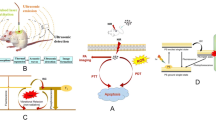Abstract
Based on the currently available theoretical and experimental data on the prospects and problems of using inorganic nanoparticles in oncology, the opportunities for design of an agent, which is a nanostructured complex of bismuth oxide and photodithazine, are discussed with a view to its potential application for detecting and possibly treating malignant neoplasms. The proposed approach mainly consists in bismuth oxide radioluminescence at a maximum of 550 nm. The initial results give reason to believe that this radiation can affect malignancy and cause the decomposition of photodithazine with the release of singlet oxygen, which enhances the effect of cell destruction.
Similar content being viewed by others
References
Meshalkin, Yu.P. and Bgatova, N.P., Prospects and problems of the use of inorganic nanoparticles in oncology: A review, J. Sib. Fed. Univ.: Biol., 2008, vol. 1, no. 3, pp. 248–268.
McDevitt, M.R., Sgouros, G., Finn, R.D., Humm, J.L., Jurcic, J.G., Larson, S.M., and Scheinberg, D.A., Radioimmunotherapy with alpha-emitting nuclides, Eur. J. Nucl. Med., 1998, vol. 25, no. 9, pp. 1341–1351.
Shchukarev, S.A., Lektsii po obshchei i neorganicheskoi khimii (Lectures on the General and Inorganic Chemistry), Leningrad: Leningrad State University, 1962, vol. 1.
Nekrasov, B.V., Kurs obshchei khimii (A Course of the General Chemistry), Moscow: Goskhimizdat, 1954.
Remy, H., Lehrbuch der Anorganischen Chemie, Leipzig: Geest and Portig, 1959. Translated under the title Kurs neorganicheskoi khimii, Moscow: Inostrannaya Literature, 1963, vol. 1.
Slesarev, V.I., Khimiya: Osnovy khimii zhivogo (Chemistry: Fundamentals of the Life Chemistry), 4th ed. (with revisions), St. Petersburg: Khimizdat, 2007.
Harborne, J.B., Introduction to Ecological Biochemistry, New York: Academic, 1978. Translation under the title Vvedenie v ekologicheskuyu biokhimiyu, Moscow: Mir, 1985.
Akhmetov, N.S., Neorganicheskaya khimiya (Inorganic Chemistry), Moscow: Vysshaya Shkola, 1969.
Semencha, A.V. and Blinov, L.N., Theoretical prerequisites, problems, and practical approaches to the preparation of carbon nitride: A review, Glass Phys. Chem., 2010, vol. 36, no. 2, pp. 199–208.
Shishokin, V.P., On the problem of the relationship between the properties of the elements and simple substances, Zh. Obshch. Khim., 1974, vol. 44, no. 8, pp. 1657–1660.
Kratkaya khimicheskaya entsiklopediya (A Short Chemical Encyclopedia), Moscow: Sovetskaya Entsiklopediya, 1261, vol. 1.
Masterov, V.F., Likholit, I.L., Potapov, V.V., and Shibanova, N.M., Time-dependent microwave absorption in Bi-system high-T c superconducting crystals, Supercond. Sci. Technol., 1993, vol. 6, pp. 593–596.
Gutenev, M.S., Tabolin, A.R., and Turkina, E.Yu., Chemical interaction of components in the (Bi2S3)1–x (P2S5)x glass-forming system, Glass Phys. Chem., 1999, vol. 25, no. 5, pp. 471–473.
Graham, D.Y., Opekun, A.R., Belson, G., El-Zimaity, H.M.T., and Carlson, M.R., Novel bismuth-metronidazole-tetracycline triple-layer tablet for treatment of Helicobacter pylori, Aliment. Pharmacol. Ther., 2005, vol. 21, pp. 165–168.
De Nol: Unique components of the efficiency in the treatment of gastroenterological diseases, Zdorov’e Ukrainy, ZU_2013_04, 61–62.
Kurilovich, S.A., Gastric cancer riskometry: What is today in the hands of the therapist, in Doklad na IV s”ezde terapevtov Sibiri i Dal’nego Vostoka, Novosibirsk, Russia, 18–19 sentyabrya, 2014 (Report to the Fourth Congress of Therapists of the Siberia and the Far East, Novosibirsk, Russia, September, 18–19, 2014), Novosibirsk, 2014.
Tret’yakov, Yu.D., Inorganic chemistry—The basis of new materials, Khim. Zhizn., 2007, no. 5, pp. 4–11.
Dianov, E.M., Bismuth-doped optical fibres: A new breakthrough in near-IR lasing media, Kvantovaya Elektron. (Moscow), 2012, vol. 42, no. 9, pp. 754–761.
Author information
Authors and Affiliations
Corresponding author
Additional information
Original Russian Text © V.A. Ovsyannikov, M.V. Zamoryanskaya, A.V. Semencha, K.A. Lycheva, T.S. Kol’tsova, O.V. Tolochko, L.N. Blinov, 2015, published in Fizika i Khimiya Stekla.
Rights and permissions
About this article
Cite this article
Ovsyannikov, V.A., Zamoryanskaya, M.V., Semencha, A.V. et al. Development of bismuth oxide-based nanopreparation for the destruction of malignant neoplasms: Theoretical prerequisites, challenges, and practical approaches. Glass Phys Chem 41, 533–536 (2015). https://doi.org/10.1134/S1087659615050119
Received:
Published:
Issue Date:
DOI: https://doi.org/10.1134/S1087659615050119




